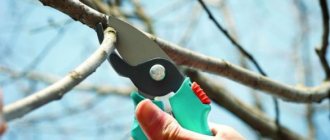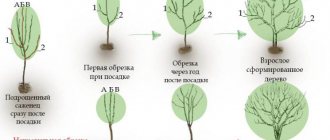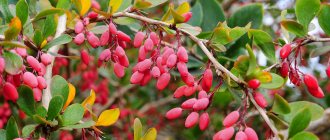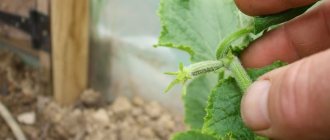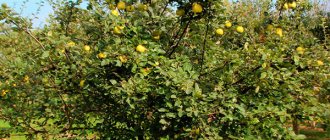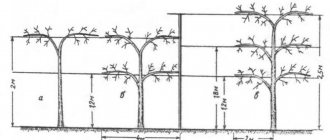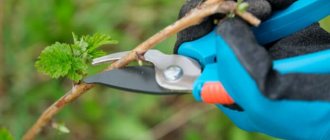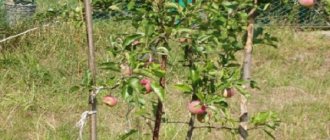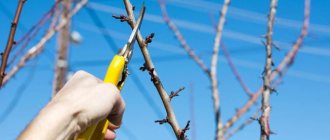Garden highbush blueberries or blueberries have recently become especially popular among gardeners. This is explained not only by the taste of the berries, but also by the unpretentiousness of the culture. However, not every novice gardener knows that to obtain a stable harvest, blueberries should be pruned annually. Otherwise, with each subsequent year, the bush will lose its potential and produce less and less fruit, and their quality will noticeably deteriorate. To understand how to prune blueberries correctly, as well as to know when it is best to do it, you need to familiarize yourself with the basic rules for this procedure.
Features of the berry garden
In the garden plots of good owners you can see a wide variety of fruit and berry plants. Let's give a brief description of garden blueberries. The tall variety of the crop is a deciduous shrub, the height of which reaches 1.2-2.5 meters. Shoots of garden blueberries can be erect or spreading, depending on the variety chosen.
The leaves of the plant are smooth, oval-shaped and rich green in color. Their length ranges from 4 to 8 cm. In autumn, the leaves acquire a red-crimson hue.
Garden blueberries bloom in late May - early June. At the same time, pink or white flowers are collected in racemes and have a faint pleasant aroma.
Fruit ripening occurs in late July - mid-August. The color of the berries can be blue or inky with a bluish coating on the skin. The fruit size is 10-20 mm, which depends on the variety of garden blueberries and the care taken. Fruit ripening occurs gradually, so they are collected in stages. The yield from 1 bush reaches 3-7 kg. Ripe fruits can hang on the branches for about 2 weeks without loss of taste and marketability.
The growing season for garden blueberries begins as soon as the air temperature rises above 0 degrees, which occurs in mid-April. The first harvest of fruits can be harvested 3 years after planting in a permanent place. The maximum yield occurs at 8-10 years. The life potential of the bush is 30 years. The stability and quality of the harvest depend on proper pruning of blueberry bushes. Therefore, this procedure is mandatory when growing this crop.
Perennial shoots of the corymbose berry can withstand frosts down to -35 degrees, and buds and flowers can withstand temperatures down to -6 degrees.
Blueberries prefer to grow in acidic soils (3.8 - 4.8 pH). At the same time, the plant cannot tolerate drying out of the roots and stagnation of moisture.
Should blueberries be pruned in spring or fall?
Blueberry is a sun-loving branched shrub, reaching a height of no more than 1 m in natural conditions. Nowadays, more than 25 varieties of garden blueberries have been selected, among which there are low- and tall-growing (up to 2.2 m) crops that are unpretentious and practically not affected by diseases and pests. The fruiting capacity of the plant increases with age. But high-quality fruits with high taste characteristics are produced only by bushes that have developed strong, healthy shoots from last year.
The necessary characteristics of a plant can only be obtained with special care. An important and obligatory stage is the spring or autumn pruning of blueberries, especially tall ones. During pruning, old, disease-affected branches that thicken the bush are removed. Without performing this procedure, the plant’s productivity drops, it grows wild, overgrown with weak shoots, and the crown becomes clogged with dry shoots, which serve as a source of disease.
Types of pruning
Pruning is a powerful method of influencing the growth processes and productivity of any plant. Therefore, depending on the purpose and desired result, choose the type of pruning of the plant and the timing of the procedure.
Types of pruning blueberry bushes:
- Formative. This type of blueberry pruning is usually carried out in the spring to create or maintain the correct crown shape. Thanks to this procedure, the bush is provided with the necessary illumination and decorativeness, and reduces the risk of disease. In the first years of life, the bush is created with a strong skeleton that can withstand the weight of the crop. Then the size and shape of the crown is adjusted. If the crown of a young bush is larger in volume than the earthen ball, then the roots will not have time to form normally before transplanting into the ground. The plant will not take root well after planting. Therefore, excess shoots are removed, and the development of the root system is activated by reducing the crown.
Advice! It is recommended to start modeling blueberry bushes from an early age, while the seedling is still in the container. The mistake is to start pruning in the 3rd year, especially in the 6th - 7th years.
- Sanitary.
Sanitary pruning solves the problem of preventing and treating plant diseases and maintaining its health. Broken, dry, infected shoots are removed from blueberries. Important! Cut branches that are affected by diseases or pests must be burned to prevent the spread of infection. - Rejuvenating. The purpose of anti-aging pruning is to stimulate the growth and fruiting of old specimens more than 10 years old. An indicator that the plant needs this procedure is a decrease in shoot growth, weak flowering, the formation of a large number of ovaries that crumble, as well as low quality fruits.
Advice! If alarming signs appear, garden blueberries can be pruned for rejuvenation without waiting until they are ten years old.
When industrially growing this crop, up to 10 fruit-bearing shoots and 3-4 annuals are left on the bush for replacement. In garden plots, the crowns of the bushes are denser, with a large number of berries, but small in size.
Autumn pruning of bushes
The formation of a strong plant skeleton is the main condition for caring for a fruit bush. Garden blueberries are no exception. In the absence of this procedure, the annual increase in young animals will not have the opportunity to fully develop and bear fruit. As a result, the bush will begin to degenerate into wild growth, and the fruits will become smaller and lose their taste.
In addition, the thickened crown of a bush is a favorable place for the development of fungal diseases, since it is poorly blown by the wind. Therefore, formative and sanitary pruning of blueberries in the fall is an integral part of caring for the berry garden. It is during this period that the sap flow in the shoots slows down, so the plant tolerates this procedure painlessly.
To prune blueberries, you should prepare pruning shears. The instrument must be pre-disinfected, which will eliminate the possibility of pathogens entering open sections.
Timing for pruning
It is recommended to remove excess shoots starting from the last ten days of October and throughout November. This period is the most suitable, since the plant is already resting, so when the shoots are cut, nutritious juice will not be released.
Carrying out the procedure later may lead to freezing of the cut shoots in the event of early cold weather.
The formation of the skeleton of the bush should begin immediately after planting the plant in a permanent place in the garden. Ignoring this rule in the first years may negatively affect the further development of the bush.
Formation of a seedling during planting
The first pruning of blueberries is carried out when transplanting the plant from a container. This will help reduce the load on the root system and allow the seedling to redirect its forces to rooting.
To do this, it is necessary to plant during the period when the growth of the aboveground part stops, which occurs at the end of September and continues throughout October.
When pruning a young seedling, you must perform the following actions:
- Remove all branched short growth that grows directly from the ground.
- Leave only strong, erect shoots (2-3 pieces), and then shorten them by half.
This will help the plant quickly and painlessly take root in a new place.
How to prune a seedling in a container
Pruning in a container is necessary if the volume of the above-ground part clearly exceeds the volume of the clod of earth in the container, that is, the roots do not have time and do not have the opportunity to grow in proportion to the crown. If you bought such a bush, then before planting, remove all the short branched growths that come out of the ground.
The seedling at the bottom has grown bushy growths that need to be removed
Only powerful vertically directed shoots should remain. They need to be shortened by a third or even half. In this way you will achieve a balance between the aboveground and underground parts of the bush. After planting, the trimmed crown will take a minimum of juices, the root system will begin to actively develop and produce new strong branches.
Proper blueberry seedlings: 2 strong vertical shoots plus small growth without branching; the root and aerial part are developed proportionally
Pruning a young seedling
Before stable fruiting begins, it is necessary to form a strong crown skeleton. If you leave the bush without attention for 1-2 years, the number of small shoots will increase, which will thicken the bush, and flower buds will form on the tops of the main shoots.
This will promote the formation of the first berries. At the same time, a thickened blueberry bush will not be able to produce a full harvest, since its forces will begin to be randomly distributed among small unnecessary shoots. Against this background, the plant weakens, and the likelihood of it being affected by fungal diseases increases. Therefore, it is worth sacrificing the first berries, removing the apical flower shoots to form a strong bush with productive shoots.
We offer recommendations for beginners on pruning blueberries in the fall in the second year after planting:
- Remove all small growth coming from the root.
- Select 3-4 shoots. They should be the strongest in appearance and point upward. These shoots will form the skeleton of the bush.
- Cut off all vertical branches growing on the remaining shoots below 30 cm from the soil surface.
- Trim off the tops where flower buds have formed.
As a result, this procedure will delay the first fruiting for some time, but will make it possible to form a strong bush, which will consist only of productive and strong branches.
Formation of an adult bush
At the age of 3-4 years, the bushes are at the final stage of formation. By this moment, they should have up to 7 lignified branches that produce a harvest, and up to 5 replacement shoots.
In the process of pruning blueberries at this age, the following actions are assumed:
- Remove all horizontal shoots whose growth is directed downwards or towards the middle of the bush.
- Cut off excess replacement shoots near the root, leaving only strong and erect ones.
- Remove all small growth growing from the root.
- Clear the main branches of vertical shoots growing below 30-40 cm from the soil surface.
- Shorten horizontal fruiting branches to a length of 10-20 cm.
The result should be a thinned bush, in which the main stems are located at a certain distance from each other, which allows them not to touch. This will help reduce the likelihood of developing fungal diseases and redirect the main forces of the plant to productive branches.
Shelter for the winter
Blueberries are a relatively frost-resistant crop. It is able to successfully overwinter if the air temperature in winter does not drop below -22 degrees. In other cases, the bushes are insulated to prepare blueberries for winter. In frosty but snowless weather, the survival rate of blueberries is significantly reduced. In this regard, in our country blueberries are always covered for the winter.
Insulation of shrubs in autumn is carried out in stages:
- Before the arrival of severe cold, the shoots are straightened and bent towards the ground. To prevent them from rising, they are secured with special restraining arches or tied with twine.
- When the first winter frosts hit, the blueberries are covered with agrofibre or regular burlap. You cannot use film for this. There is a high probability that the plant will rot and become infected with fungus.
- When snow falls, it is thrown over a covered bush. Such additional insulation will protect against the destructive effects of cold.
- With the arrival of spring, the covering is removed. Then they inspect the blueberries and cut off the ends of branches damaged by frost. Possible frosts do not pose a danger to blueberries. Its buds and flowers can withstand temperatures down to -8 degrees.
Read also: Potato varieties and hybrids
Sanitary and anti-aging pruning of blueberries
Subsequently, the bush is cleared of excess and unproductive shoots. With proper care, blueberry bushes can produce crops for 30 years. But at the age of 5-6 years, their potential decreases, since they are overgrown with a large number of side shoots at the top. This leads to a decrease in the quality of the fruit.
The situation can be corrected using a special technique. To do this, it is necessary to identify one strong vertical shoot in the middle part of the main branch and make the transition to it. This will require shortening the obsolete branch directly above it.
If there is no such shoot, it must be cut off completely at the root. And in return, leave a young replacement shoot. When rejuvenating blueberry pruning, you should cut off all branches thicker than 25 mm, since they have completely exhausted their fruiting potential. In one season, you can remove about 20% of old branches without damaging the plant.
In addition, sanitary pruning of tall blueberries should be carried out annually in the fall. It includes cleaning the bush from damaged, broken and dry shoots.
What you need to know before the procedure
Before pruning the bush, it is necessary to determine the age of the blueberries. It is advisable not to touch the young bush - to give it the opportunity to get a little stronger. When pruning blueberries, you need to remember that fruiting occurs on two-year-old branches and older shoots.
If you cut off the ends of old branches, you may be left without a harvest. After 5 years, the yield of the branches decreases. The renewal of the bush occurs due to the root growth emerging from the ground, but in the first years of life it is removed, leaving 5-10 main shoots.
At what age does the bush form?
It is recommended to prune blueberries from 2 or 3 years of age. First of all, remove small branches growing from the base. Only 3-5 are left, and in subsequent years - 6-10 powerful vertical shoots. For example, a three-year-old bush should have 4 old branches and 3-4 young ones.
Optimal timing
Sanitary pruning is carried out in spring or autumn. During this procedure, the plant must be in the deep sleep phase. True, some gardeners recommend pruning in the summer - during the period of active development of the crop.
Summer pruning has its advantages - it allows you to see dry, diseased and non-fruiting branches. Formative is carried out in early spring - before the buds awaken and the juices begin to flow. You can form a crown in the fall, just before winter, when the leaf fall ends.
Required materials and tools
To carry out the procedure you will need the following garden tools:
- pruning shears - for removing thin branches with a diameter of up to 1.5 centimeters;
- lopper - cuts thick (up to 3 centimeters) shoots;
- garden hacksaw - used for cutting large and old branches;
- garden knife - for removing thin branches, allows you to make oblique cuts.
See also
How to properly preserve cloudberries for the winter at home
Read
When is it necessary to prune a bush at the root?
There are situations when only radical pruning can rejuvenate a plant. This procedure means cutting the bush at the root.
Main reasons:
- The bush began to dry out in the absence of timely watering during the hot period.
- The plant has degenerated into a wild plant because it has not been cleared for 5-6 years.
- All the main fruit-bearing shoots have become obsolete, which has led to a loss of harvest quality.
After radical pruning of blueberries at the root, it is necessary to provide the plant with adequate nutrition and timely watering. Then within 2-3 years the bush will be able to recover.
Care after pruning
After clearing the blueberry bush in the autumn, it is necessary to treat the cuts with garden varnish. This must be done if the thickness of the shoot is 10 mm or more. This measure will eliminate the possibility of pathogens getting into open wounds.
In addition, caring for blueberries in the fall includes fertilizing to restore the vitality of the plant before winter. During this period, it is necessary to use mineral fertilizers with a high content of phosphorus and potassium (15 g of superphosphate and 20 g of potassium magnesium per 10 liters of water).
The use of nitrogen fertilizers during this period is prohibited, as this can lead to freezing of the bush.
By layering
This method has pros and cons. The positive side is that young bushes that have not had time to sprout many shoots are suitable for propagation; the negative side is that it is a labor-intensive process that takes a lot of time. The procedure is carried out in the summer, when the shoots are in the active growth phase.
First you need to prepare the soil around the trunk of the bush. Loosening will be enough. The most powerful shoots are selected and laid on the ground. It is necessary to make small grooves in the soil (about 7 cm deep). The length of the hole depends on the size of the shoot. The shoot is placed in a hole and covered with sawdust.
We recommend reading how to care for blueberries in the fall.
To prevent the shoot from rising and stretching upward, it can be secured with wire by sticking it into the ground. It is better to install the wire in the area of developed buds.
The hole must be filled with sawdust and watered generously. After a couple of years, the cuttings will take root and can be transplanted to a new location, separated from the main bush.
Preparing for winter
Blueberries have a high level of frost resistance, but in the event of a snowless winter, plants under 3 years of age and young one-year growth may suffer from hypothermia.
Therefore, caring for blueberries in the fall and preparing for winter involves the following activities:
- At the end of leaf fall, the shoots should be straightened and pressed to the ground using twine or special holding arches.
- When persistent frosts occur, they should be covered with agrofibre or burlap. And to cover small bushes you can use coniferous spruce branches.
- When snow falls, lightly sprinkle the shoots with it, which will further insulate them.
These recommendations will help preserve not only young shoots, but also all the fruiting branches that form at the top, which guarantees a generous harvest next year.
Further care for blueberries
Removing and pruning branches is very stressful for plants. In order for the yield to remain at a high level, blueberries must fully recover, so they are provided with proper care.
Processing slices
The sections remaining after removing thick branches are treated with garden varnish or a special aerosol intended for similar purposes. Experts recommend processing the cut if its diameter exceeds 2 cm. First, the surface must dry; wet cuts should not be covered over.
Garden varnish is easy to prepare yourself from available ingredients:
- 4 parts rosin;
- 2 parts wax;
- 1 part visceral fat.
First you need to melt the fat and then add other ingredients to it. The mixture is boiled over low heat for 30 minutes, stirring constantly. Store the finished composition in a closed container.
Disease Prevention
After spring and autumn pruning, blueberries and the soil underneath are sprayed with a urea solution or 1% Bordeaux mixture. The procedure for removing shoots reduces the immunity of blueberries, which increases the risk of disease. The shrub may be affected by:
- Phomopsis - the shoots begin to dry out and the bush dies;
- physalosporosis - the disease manifests itself in the appearance of reddish convex spots;
- Anthracnose is a common and dangerous fungal infection;
- powdery mildew - the leaves are covered with a white fluffy coating.
Spraying is carried out using personal protective equipment. It is necessary to wear a respirator, goggles, and closed clothing.
In spring, the shrub can be additionally treated with a growth stimulator. Suitable: “Zircon”, “Epin-Extra”, “Gumistar”, “Ekogel”, “Silk”. This will not only enhance the formation of new shoots, but also strengthen the plant, making it less susceptible to disease.
Mulching
In the off-season, it is necessary to replace used mulch with fresh materials; pathogenic microorganisms accumulate in rotten litter. The mulch layer can be removed not completely, but partially by replacing damaged areas. Sawdust and coniferous tree chips are most suitable as mulch for blueberries.
As organic matter decomposes, it will supply the plant with nutrients, further protecting the soil from drying out and helping to maintain the required pH level. The root system of blueberries is located at the very surface of the soil, so the level of humidity and acidity of the top layer of soil are of considerable importance for the crop.
Pruning helps maintain blueberry productivity and health at the desired level. The procedure must be carried out during the period of biological dormancy of the bush. Blueberries require regular pruning. Bushes should be cleaned and thinned at least once a year. The rejuvenation procedure is carried out as needed.
